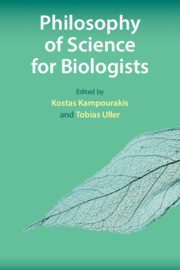Book contents
- Philosophy of Science for Biologists
- Philosophy of Science for Biologists
- Copyright page
- Contents
- Contributors
- Preface
- 1 Why Should Biologists Care about the Philosophy of Science?
- 2 What Constitutes an Explanation in Biology?
- 3 What Is Biological Knowledge?
- 4 What Is the Nature of Theories and Models in Biology?
- 5 How Are Biology Concepts Used and Transformed?
- 6 Why Does It Matter That Many Biology Concepts Are Metaphors?
- 7 How Do Concepts Contribute to Scientific Advancement?
- 8 How Can Conceptual Analysis Contribute to Scientific Practice?
- 9 What Methods Do Life Scientists Use?
- 10 Is It Possible to Scientifically Reconstruct the History of Life on Earth?
- 11 What Is the Basis of Biological Classification?
- 12 What Is the Nature of Scientific Controversies in the Biological Sciences?
- 13 What Is the Relation between Facts and Values in Biological Science?
- 14 A Philosopher in the Age of Creationism
- 15 How Can We Teach Philosophy of Science to Biologists?
- Further Reading
- Index
- References
7 - How Do Concepts Contribute to Scientific Advancement?
Evolutionary Biology As a Case Study
Published online by Cambridge University Press: 04 September 2020
- Philosophy of Science for Biologists
- Philosophy of Science for Biologists
- Copyright page
- Contents
- Contributors
- Preface
- 1 Why Should Biologists Care about the Philosophy of Science?
- 2 What Constitutes an Explanation in Biology?
- 3 What Is Biological Knowledge?
- 4 What Is the Nature of Theories and Models in Biology?
- 5 How Are Biology Concepts Used and Transformed?
- 6 Why Does It Matter That Many Biology Concepts Are Metaphors?
- 7 How Do Concepts Contribute to Scientific Advancement?
- 8 How Can Conceptual Analysis Contribute to Scientific Practice?
- 9 What Methods Do Life Scientists Use?
- 10 Is It Possible to Scientifically Reconstruct the History of Life on Earth?
- 11 What Is the Basis of Biological Classification?
- 12 What Is the Nature of Scientific Controversies in the Biological Sciences?
- 13 What Is the Relation between Facts and Values in Biological Science?
- 14 A Philosopher in the Age of Creationism
- 15 How Can We Teach Philosophy of Science to Biologists?
- Further Reading
- Index
- References
Summary
In 1962 Thomas Kuhn published one of the twentieth century’s most fruitful and most scandalous books, The Structure of Scientific Revolutions (Kuhn 1962). He argued that the form of inquiry we call natural science periodically undergoes more or less sudden shifts in what he called paradigms. His paradigmatic examples were the displacement of Ptolemaic astronomy by Copernican heliocentrism in the sixteenth century; and in the late eighteenth century the discrediting of alchemy, which sought to turn one element into another, by Lavoisier’s chemistry, which took the elements to be atomic and chemical change to consist of compounding these elements in particular ways. These are not especially disconcerting cases, since they helped give birth to modern science in the first place. What was disconcerting was Kuhn’s contention that, even after it was up and running, modern science – institutionalized practices of inquiry in which hypotheses and theories are rigorously tested by careful observation and experimentation – shows the same pattern. Disciplinary communities, he claimed, typically rally around a new paradigm until enough anomalies pile up to invite an even newer one.
- Type
- Chapter
- Information
- Philosophy of Science for Biologists , pp. 123 - 145Publisher: Cambridge University PressPrint publication year: 2020
References
- 1
- Cited by



